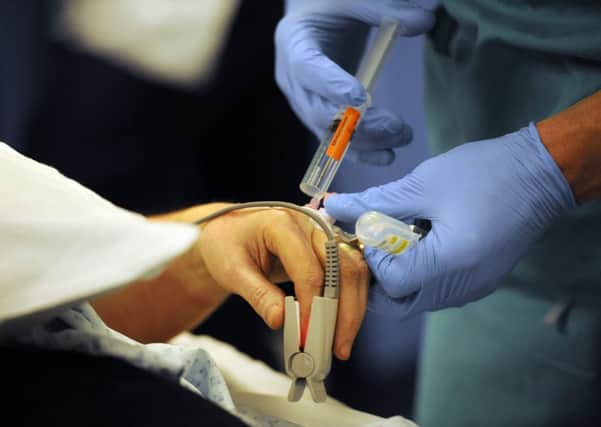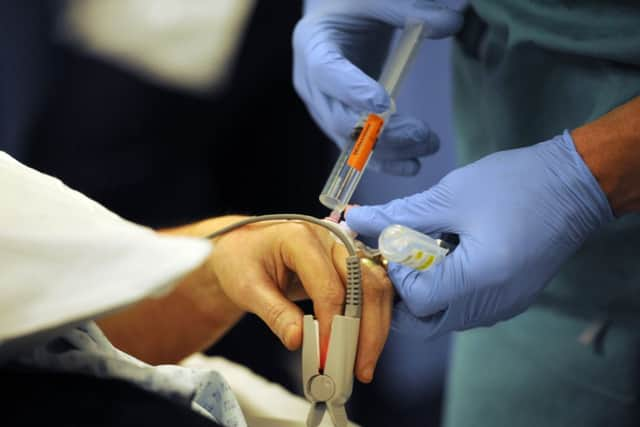Hospital patients wait weeks to see senior doctor


A review prompted by raised mortality rates at hospitals in NHS Lanarkshire outlines a raft of serious concerns about the care being provided, including gaps in nursing levels and patients potentially being left for two weeks without being seen by a senior doctor.
Fears about care in the out-of-hours period were also highlighted in the 90-page report making 21 recommendations for urgent improvements at the board’s three hospitals.
Advertisement
Hide AdAdvertisement
Hide AdMedical leaders described the findings as “depressing but not surprising” following growing fears voiced in recent months about levels of staffing and bed numbers across NHS Scotland to deal with the ageing population.


Opposition politicians said last night patients had died unnecessarily due to NHS failings.
The review, published yesterday by Healthcare Improvement Scotland (HIS), a body set up to help deliver a better quality of service, was ordered in August when figures suggested that Monklands Hospital in Airdrie, Hairmyres Hospital in East Kilbride and Wishaw hospital had experienced significantly higher mortality rates than the Scottish average at some point in the previous 18 months.
When the figures were later revised, due to late data, only Monklands was left with a higher hospital standardised mortality ratio – a measure of predicted deaths compared to actual deaths. It had seen higher rates since April 2012.
As part of the review, the team spoke to more than 200 members of staff, received feedback from over 300 patients and carers and reviewed the medical records of 152 patients who died.
Staffing levels – both doctors and nurses – particularly out of hours – were a major concern highlighted by those who contributed to the report.
While the medical workforce in Lanarkshire has increased, the report said recruitment and retention were challenging with a 16 per cent vacancy rate for consultants and 14 per cent for speciality doctors.
At Hairmyres and Monklands, consultants were having to sleep in hospital overnight because of a lack of other senior doctors to support junior staff.
Advertisement
Hide AdAdvertisement
Hide Ad“Consultants in emergency medicine expressed the view that a new model of care is required as they cannot sustainably staff a 24-hour, seven-day a week emergency medicine response in each of the three sites,” the experts’ report said.
At Monklands, staff told the review team about delays in securing a doctor to respond to patients whose condition was deteriorating.
At Hairmyres staff on general medicine wards reported long waits to review patients if doctors were on holiday. “This means a patient could go up to two weeks without seeing a senior doctor.” The report said that lack of cover for consultants’ leave in certain specialities was also identified at Monklands and “may be more widespread”.
While many patients and carers praised staff, others raised concerns about long waits for buzzers to be answered and families being left to clear soiled bedclothes and clean rooms themselves.
The report said: “Nursing staff consistently raised concerns that the number and grade of staff on duty was not always sufficient to respond to the workload, particularly out of hours.”
Concerns about bed pressures and patients being left on trolleys for long periods waiting for beds was also highlighted.
HIS said while it was not possible to draw “definitive reasons” behind the high death rates in Lanarkshire, the review concluded that quality of care may have contributed to them.
So-called “boarding” of pat-ients – where they are moved to a ward outside the speciality they should be treated in to make space elsewhere in hospitals – was found to happen regularly in the board’s hospitals. The practice has been linked to poorer outcomes for patients.
Advertisement
Hide AdAdvertisement
Hide AdFor the period January-March 2013, 4,044 patients were boarded at Hairmyres, 3,066 at Monklands, and 1,883 at Wishaw Hospital.
Robbie Pearson, of the HIS, said: “Although the review team found a service where clinicians and managers are working hard to do the right thing, sometimes in a difficult environment, the team concluded that a broad range of improvements are necessary for NHS Lanarkshire to continue its commitment to delivering safe and effective patient care.”
Health secretary Alex Neil said the Scottish Government had established an expert governance and improvement support team to help NHS Lanarkshire make the improvements.
He pointed out that despite the concerns, death rates at all three hospitals had fallen since 2007 – though not as much as the Scottish average.
Across the country, rates have fallen by 12.4 per cent since 2007, while at Monklands they are down 4.3 per cent, at Hairmyres 7.1 per cent and at Wishaw, 17.6 per cent.
Dr Neil Dewhurst, president of the Royal College of Physicians of Edinburgh, said: “The findings make depressing, but not surprising reading.”
Scottish Labour’s health spokesman Neil Findlay said: “People have died unnecessarily in Lanarkshire due to failures within the NHS.”
Dr Iain Wallace, NHS Lanarkshire’s medical director, said: “This report identifies some challenges within emergency care services that we are already taking action to address.
Advertisement
Hide AdAdvertisement
Hide Ad“We have already changed the pattern of medical cover in late evenings and weekends.”
Key points
The recommendations of the report include that NHS Lanarkshire must:
• Ensure that its existing plan to produce accurate and timely patient discharge summaries is implemented on schedule.
• Review processes for collecting patient and carer experience data, to ensure that patients and carers feel able to provide honest feedback.
• Strengthen its ability to reliably identify patients whose clinical condition is deteriorating, and deploy an effective, timely and appropriate response to the patient’s needs.
• Take prompt action to develop and implement a credible and practical model for medical staffing that meets patient needs, including robust arrangements for when staff are on leave.
• Ensure further review of nurse numbers and skill mix is considered in association with work to address vacancy levels, bank usage, support to improve rostering practices and appropriate non-clinical/administrative support for senior charge nurses.
Cancer: Health boards missing target to begin treatment within set periods
Advertisement
Hide AdAdvertisement
Hide AdHalf of health boards in Scotland have missed a target for cancer patients to begin treatment within two months.
Figures yesterday showed that seven boards failed to hit the standard for getting at least 95 per cent of patients with a suspicion of cancer to their first treatment within 62 days of being urgently referred by their GP.
NHS Grampian scored lowest with 89.5 per cent, while Orkney was the only board to hit 100 per cent, according to the latest official statistics covering July to September.
The target was also missed by Highland (93.2 per cent), Borders (93.8 per cent), Fife (93.2 per cent), Ayrshire and Arran (94 per cent), Greater Glasgow and Clyde (94.1 per cent), and Shetland (93.8 per cent).
The national average was slightly below the target at 94.5 per cent – the same as the previous quarter.
All 14 boards passed a second target to ensure 95 per cent of all patients, regardless of how they were referred, wait a maximum 31 days from decision to treat to their first treatment.
In this case, the national average was 98.1 per cent, up slightly on the previous figures.
The figures also showed variations between different types of cancer. Only 88.6 per cent of head and neck cancers were seen within two months, compared to 98.7 per cent of breast cancers.
Advertisement
Hide AdAdvertisement
Hide AdOthers missing the target included cervical cancer at 90.9 per cent starting treatment within 62 days, 93.7 per cent for colorectal cancers, 89.8 per cent for urological cancers, such as prostate cancer, and 93.2 per cent for ovarian cancers.
Health Secretary Alex Neil said: “We understand that having to wait for tests or to begin cancer treatment can be frightening and at the very least frustrating. When it comes to cancer, we are determined to take all the necessary action to improve earlier diagnosis, advance the treatments available to patients and invest in staff and equipment.”
Labour’s health spokesman Neil Findlay said: “Half of Scottish health boards are still missing the 62-day cancer waiting time target. That’s hundreds of Scots across the country left with an agonising wait to begin treatment.
“What’s just as worrying is that seven out of the ten types of cancer that are covered by the guarantee are falling below the expected standard.”
Lib Dem health spokesman Jim Hume said: “It is a grave reflection of the state of our health boards.”
Children: More under-18s in adult mental health wards
The number of children with mental health problems being admitted to adult wards in Scotland has increased, figures show.
Child unit psychiatric hospital admissions in 2012-13 stood at 20.8 per 100,000 people under 18 – an increase from 19.2 in
2011-12.
Child and Adolescent Mental Health (CAMH) service admissions to adult psychiatric wards also increased from from 16.5 per 100,000 people under 18 in 2011-12 to 20.7 in 2012-13.
Advertisement
Hide AdAdvertisement
Hide AdExperts believe child admissions to adult psychiatric services should be avoided to make sure they have the best specialist care. The figures also revealed that 94 per cent of people seen by a CAMH service started their treatment within 26 weeks of being referred in the quarter ending 30 September, 2013.
A total of 5,370 people were waiting to start treatment at CAMH services during the quarter, while 375 of these had been waiting for more than 26 weeks.
Liver disease: Scotland counts the cost of cheap alcohol
Scotland has one of the highest death rates from chronic liver disease in Europe, new figures reveal.
Data from the Scottish Public Health Observatory shows a sharp increase in the mortality rate for the disease between 1993 and 2003, followed by a decline.
But deaths are still almost 60 per cent higher than they were 30 years ago and almost 70 per cent higher than the average across the UK. Compared with countries in most of Europe, only Hungary has a higher mortality rate than Scotland, the Scottish Government said.
There were around 13 deaths per 100,000 of the population in Scotland in 2012.
Meanwhile, in the three-year period 2009 to 2011, mortality rates were over five times higher in the most deprived fifth of the population compared to the least deprived.
Public health minister Michael Matheson said: “The death and suffering caused by chronic liver disease is far too high and much of the blame lies with our relationship to alcohol. “We need to reduce the toll alcohol is taking on our society.”
SEE ALSO
• Subscribe to The Scotsman Apple and Android tablet apps
Advertisement
Hide AdAdvertisement
Hide AdOur apps offer the latest news throughout the day as well as complete electronic copies of the newspaper.
The apps - which are available on Amazon Appstore, Apple iTunes and Google Play, have been designed to offer readers a dynamic way to keep up to date whether at home or on the move.
They feature full articles, videos and picture galleries plus the ability to browse through complete downloadable editions of the paper which can also be read offline later.
Print subscribers of The Scotsman are entitled to any version of the app to suit their device as part of their subscription.
Alternatively readers can subscribe to the app through the app stores, and will get 30 days free access.